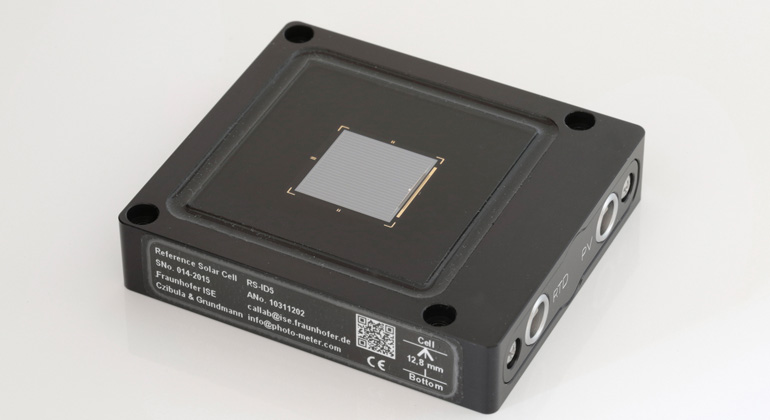Fraunhofer ISE Has Developed a New Generation of Reference Cells
Optimized Structure Allows the Calibration of the Expanded Infrared Spectrum
Scientists at the Fraunhofer Institute for Solar Energy Systems ISE have developed a new version of reference cells for calibrating solar cells. At the institute’s calibration laboratory, a new cell type based on negative, conductive silicon material (n-type), was incorporated while the structure of the reference cell was optimized. For the calibration of different types of solar cells, the reference cell’s spectral response can be accurately adjusted using optical filters, thereby significantly reducing any measurement uncertainty. The new version of the reference cells meets all international standards (World PV Scale and IEC 60904-2). The new cells will allow test laboratories and cell and module manufacturers in particular to significantly improve the quality of their measurements. The outdoor version of the cell also makes it possible to take exact measurements of solar insolation in the field.
The more accurately the irradiation can be measured, the more accurately the performance of PV systems can be determined. For many years, Fraunhofer ISE’s calibration laboratories – CalLab PV Cells and CalLab PV Modules – have been measuring various types of solar cells and PV modules for international customers pursuant to international norms. Fraunhofer ISE also offers globally recognized services for yield forecasting and monitoring PV systems. Over the past 15 years, advances have been made in the development of reference cells for indoor and outdoor measurements, and technical consulting services for customers such as test laboratories and plant operators, has been expanded. With their most recent development success, the Freiburg scientists have been able to further improve their already well-established reference cells, and bring to the market a new version of reference cells which meet the World PV Scale Standard (WPVS).
“For our new version of the WPVS reference cells, we’ve completely changed the interior structure,” says Stefan Brachmann of Fraunhofer ISE. “The reference cells were optimized with respect to linearity, stability, homogeneity, and durability.” For the first time, the Freiburg researchers incorporated a silicon solar cell made of n-type material, which allows for a significant expansion of the spectral response (see chart) in comparison to the p-type reference cells, which are still available. The new reference cells are therefore particularly suited for the calibration of new solar cells and modules that are also n-type based and have better spectral response than the traditional p-type based reference cells. The thermal coupling of the cell and housing was also improved, reducing the temperature gradient between the solar cell and the housing of the reference cell. In combination with optical filters, the new reference cells can be adjusted for the calibration of various solar cell technologies. The specific recommendation for use is available on the institute’s website.
Teams in the areas of solar cell development and calibration worked together at Fraunhofer ISE to make the new version of the WPVS reference cells a reality. N-type solar cells are being both produced and calibrated under one roof. As the integration into housing will be carried out by long-standing suppliers, the entire manufacturing cycle of the reference cells can be traced. This process increases the reliability and quality of the products. In addition to the calibration laboratories CalLab PV Cells and CalLab PV Modules, scientists at Fraunhofer ISE specializing in the development and characterization of solar cells, especially material and cell analysis, were also involved in realizing the new version of the WPVS reference cells.








